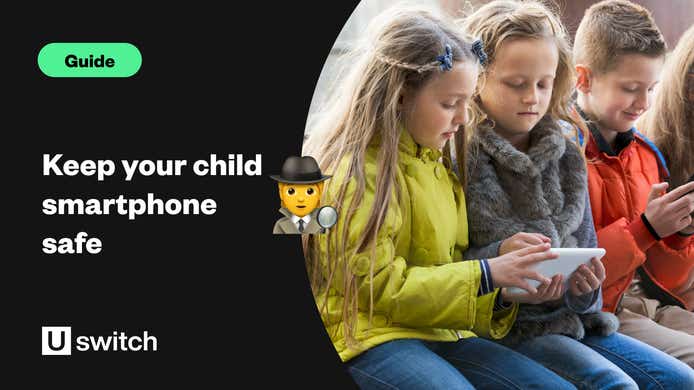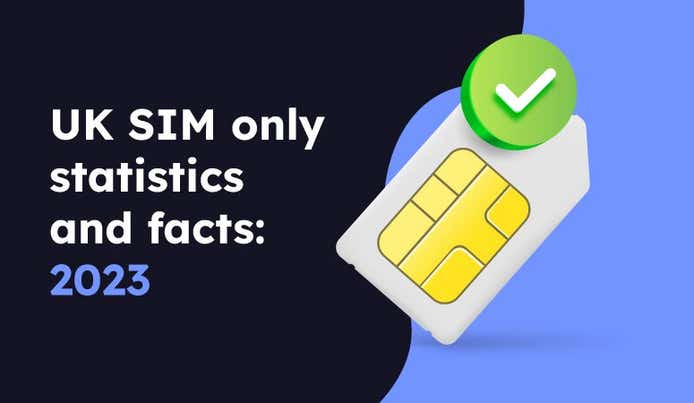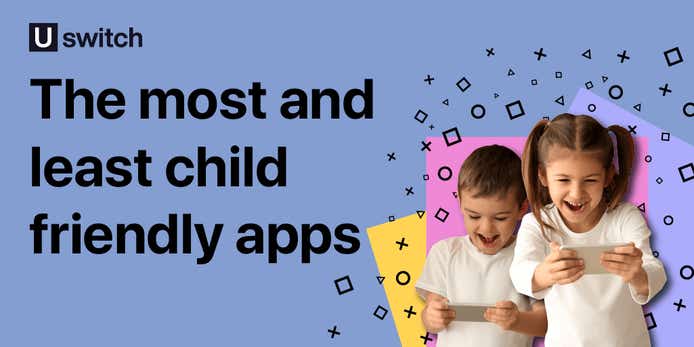Recent research from the Advertising Standards Authority suggests that up to 93% of UK children aged 11-17 have social media accounts. Of 11-12-year-olds, who are below social media age restrictions, around 86% have social media accounts. With so many of today’s children already joining the digital world, what are the safety issues parents and guardians need to watch out for?
In this report, we reveal the social media platforms that see the highest amount of posted content that violates community guidelines, as well as the guidelines that are most often broken.
We’ll also analyse the best-rated parental control iPhone and Android apps to help you keep your kids safe with their first mobile deal, whether that be on a pay monthly plan or a SIM only deal.
How many children are on social media?
Research from Ofcom suggests that 77% of 8-17-year-olds in the UK have social media accounts, which equates to almost 4 in every 5 UK children between the ages of 8 and 17.
When we look at the 8-12 age range specifically, we see almost 3 in 5 of these children have social media accounts. This is troubling, as generally speaking social media age restrictions have a minimum age of 13, meaning all children in this age range have falsely registered their age to create their account.

Ofcom also revealed the percentages of children who are falsely registering their age so they have access to adult content (16+ and 18+). Of our 8-12 age range (all of whom are registering false ages to have these accounts), 39% have false ages of 16 or over, and a concerning 23% have false ages of 18 or over.
Of all UK children aged 8-17, it is estimated that a shocking 32% have falsely registered their ages on social media platforms as over 18. That is almost 1 in every 3 children aged between 8 and 17. Having a false age of 18 or over means these children have access to adult content, including violence, nudity, and other sensitive media.

How much social media content is removed for breaking guidelines?
Looking at the above social media mobile statistics, you might be thinking that there’s nothing to worry about. But, social media can be a lawless land, and these days, you can find just about anything, or interact with just about anyone, through social media.
Some platforms flood users with content that they may not have sought out. Many social media homepages show posts from other users, which could be anything. Social media companies are quite good at spotting and removing any dangerous data, but it’s useful to get a feel of how much harmful data there could be on each social platform.
Here are the social media platforms with the most actioned content over 2022. Actioned content refers to any content that has been removed, covered with a warning, or any accounts that have been disabled because they could be harmful or break community guidelines.

1. TikTok
Active users - 1,092,000,000
Total content actioned - 412,750,298
Total content actioned per 100,000 users - 37,798
TikTok saw the most content actioned per 100,000 users in 2022 with a staggering 37,798 videos removed. The most common reason for content to be removed on TikTok was ‘Minor Safety’ (meaning any content potentially harmful to minors), where 28.5 million videos were removed for this reason over 2022, a massive 2,613 per 100,000 users.
The next most common reasons for video removal on TikTok were ‘Illegal Activities and Related Goods’, where 23.5 million videos were removed at a rate of 2,150 per 100,000 users, and ‘Adult Nudity and Sexual Activities’, where 11.0 million videos were removed at a rate of 1,004 per 100,000 users.
When we look at where the majority of actioned content was first posted, we see that the United States posts the most harmful content on TikTok at a total of 13,052,923 in 2022. Pakistan posted the second-highest volume at 12.6 million, followed by Indonesia with 7.6 million in 2022.

2. Facebook
Active users - 2,963,000,000
Total content actioned - 601,600,000
Total content actioned per 100,000 users - 20,304
Facebook has seen the second-highest volume of actioned content over the last year at a whopping 20,304 per 100,000 users. The most common reason content was actioned on Facebook was ‘Adult Nudity & Sexual Activity’, where a total of 127.9 million posts were removed, equating to 4,317 per 100,000 users, almost a quarter of all posts actioned.
The second most common content to be actioned on Facebook was ‘Violent & Graphic Content’. There were 110.7 million posts actioned over 2022 that were deemed violent and graphic, a rate of 3,736 per 100,000 users. ‘Child Endangerment: Sexual Exploitation’ was, worryingly, the third most common type of content to be actioned at 3,112 per 100,000 users (a total of 92.2 million posts over 2022).

3. Instagram
Active users - 2,000,000,000
Total content actioned - 185,841,900
Total content actioned per 100,000 users - 9,292
Instagram saw the third-highest volume of content actioned over the year 2022 at 9,292 per 100,000 users. While this is half that of Facebook and a third that of TikTok, it is still a large amount of content to be removed from a social media site over a year.
The most common reason for content to be actioned on Instagram was ‘Adult Nudity & Sexual Activity’, making up 42.9 million of the total 185.8 million posts actioned on Instagram. ‘Adult Nudity & Sexual Activity’ posts were actioned on at a rate of 2,145 per 100,000 users, followed by ‘Violent & Graphic Content’ at a rate of 1,460 per 100,000 users, and ‘Bullying & Harassment’ content at a rate of 1,210 per 100,000 users.

4. Twitter
Active users - 372,900,000
Total content actioned - 11,016,493
Total content actioned per 100,000 users - 2,954
Twitter’s total 2022 data is currently unavailable, but looking at 2021 we can see that Twitter saw a total of 2,954 posts actioned per 100,000 users, coming to a total of 11 million over that year.
Looking at the second half of 2021 (the third and fourth quarters) we can also see that the most common offence for content on Twitter was ‘Abuse/Harassment’, which saw a total of 1.3 million posts actioned over Q3 and Q4 of 2021 (360 per 100,000 users). This was followed by ‘Hateful Conduct’, with 347 posts actioned per 100,000 users (1.2 million total) and then by ‘Sensitive Media’ with 308 per 100,000 users (1.1 million total).

5. YouTube
Active users - 2,527,000,000
Total content actioned - 19,646,586
Total content actioned per 100,000 users - 777
Over 2022, YouTube actioned a total of 19.6 million pieces of content. This equates to a rate of 777 per 100,000 users, the lowest of all social media platforms we have looked at. This is a respectable rate for YouTube, considering the platform has the second-highest volume of active users at 2.5 billion.
Full 2022 data for YouTube is unavailable, but we can look at data from the last quarter of 2022 to see what type of content is most commonly removed. ‘Child Safety’ was unfortunately the most common type of content actioned on, at a rate of 76 per 100,000 users. ‘Harmful or Dangerous’ was next with 38 per 100,000 users, followed by ‘Violent or Graphic’ content with 37 per 100,000 users.
India is responsible for the highest volume of harmful content posted on YouTube, recording a total of 1.7 million posts removed over 2022. India is followed by the United States accounting for 0.6 million actioned posts and Indonesia with 457,662.

What do parents and guardians think about the state of mobile safety for children?
We surveyed the public to see what they thought about the topic of children’s mobile phones and social media safety. We asked a panel of over 600 UK parents and guardians with children aged 6-16 how strongly they agreed with the following statements.
“Your child's mobile phone usage impacts their academic performance”

Just under a quarter (23%) of parents disagreed with this statement (only 6% strongly disagreed). This compares to almost half of our parents (48%) who agreed, or strongly agreed, with this statement, suggesting that UK parents are more inclined to agree that phone usage impacts their child’s academic performance.
“You would feel concerned about your child's safety during school hours if they did not have a mobile phone”

Over half of the respondents (55%) agreed or strongly agreed with this statement, suggesting that while many UK parents and guardians believe phone usage could hinder our children’s academic performance, there is also a majority who believe phones have the benefit of improving their child’s safety during school hours. Only 21% of parents disagreed with this statement to some extent.
“You are concerned about your child's usage of mobile phones and social media”

This statement had the highest consensus among parents on our panel. Almost two-thirds (612%) of our parents and guardians agreed that they are concerned about their children’s usage of mobile phones and social media.
It goes to show that when we discuss mobile phones and children, what most parents can agree on is that they are concerned about their child’s usage of their phones and access to social media. As mentioned, up to 93% of UK children aged 11 to 17 have social media accounts.
If you are concerned about your child’s safety while using their mobile phones, check out the top-rated parental control apps below.
The highest-rated parental control iOS and Android apps

To help keep your child safe on their smartphone, we analysed 14 of the most popular parental control apps on the market right now to see which have the highest ratings. Our weighted average rating takes into account the number of ratings each app has received on both the App Store and the Play Store.
1. Google Family Link
App Store Rating - 4.5
Play Store Rating - 4.5
Weighted Average Rating - 4.5
Google Family Link is the highest-rated parental control app aimed at protecting your child while they use their devices. Family Link allows parents to restrict certain content, approve or disapprove apps their child wants to download and set maximum screen times.
2. Kidslox
App Store Rating - 4.3
Play Store Rating - 4.3
Weighted Average Rating - 4.3
Similar to Family Link, Kidslox allows you to block or disable internet access to a selection of the most popular (and most disruptive) gaming and social media apps, including the likes of TikTok and Facebook. You will be able to set up your child's browser so that they can only see search results allowed by Google SafeSearch and YouTube restricted mode.
3. FamilyTime
App Store Rating - 2.9
Play Store Rating - 4.2
Weighted Average Rating - 4.2
FamilyTime is similar to Kidslox in that you can manage your child’s screen time and block unwanted apps from your child’s phone. The app also provides a platform for children to reach out to parents or guardians instantly if they are in trouble with panic alerts.
If you're looking for a mobile phone deal for your child, check out our best SIM only deals to help keep costs down.
Tips on keeping children safe while using mobile phones
1. Respect social media age restrictions
Research from Ofcom suggests that up to two-thirds of children between the ages of 8 and 12 had help from their parents when setting up social media accounts. Many social media sites, including TikTok, Facebook, Instagram, Twitter, and YouTube, require users to be at least 13 years old. Don’t set up accounts for your child if they are under the age of 13.
2. Take an interest in how they use their phone
Know what apps your child is using and has access to. In particular, take note of what social platforms they’re on and how much they are using them. This can help pre-empt any problems like cyberbullying, oversharing or sleep trouble if they are using their phones too much too late at night. Make sure your child is also following any age restrictions on apps and games.
3. Set limits on phone use
Simple rules around screen time can help your child build good phone habits. Set limits on how long children are allowed to use their phones, as well as when and where. For example, banning phones from the dinner table or while they are doing homework.
4. Set up a parental control app or software
Such apps can help you monitor your child’s safety on their mobile phones. You can track their locations, restrict harmful content, approve or ban certain apps from being downloaded on their devices, and more. Check out some of the best mobile networks for kids and teens.
Explore mobiles studies.
Visit our mobiles studies to learn more if you’re seeking for the newest mobile statistics or want to get inspiration from our experts’ research.
FAQs
What are the highest-rated parental control iPhone and Android mobile apps?
Google Family Link, Kidslox, and FamilyTime are the highest-rated parental control apps right now. These apps have average ratings across the App and Play stores of above 4/5. They each allow you to monitor your child's online experience, restrict certain content, approve or disapprove apps, and set maximum screen times.
How can I improve my child’s social media safety?
Understanding the potential risks involved with social media and how these could affect your child’s safety are key to improving your child’s social media safety. Most of the popular social media services require users to be at least 13 years of age before they can register.
You can also take note of the platforms your child is using if they are of age and what they are using it for. You can also install parental control apps which allow you to restrict certain apps and web pages from being accessed on your child’s device.
What are social media age restrictions?
Social media age restrictions are restrictions on how old you have to be to set up a social media account. This age is usually 13 across most social media sites. But, restrictions can vary depending on the platform and the country. There are also age restrictions for certain content, such as violence and nudity, that requires ages of 18 plus. This is to prevent those under age from accessing this type of content.
It's important to note that these age restrictions are set by the social media platforms themselves, and it is ultimately the responsibility of parents and guardians to ensure that their children are using social media platforms safely and appropriately.
Methodology and sources
General statistics around the number of children in the UK using social media apps and registering with false ages were taken from ASA and Ofcom.
Data on the volume of actioned content and the reasons for content to be actioned were taken from each social media’s respective transparency reports [TikTok, Instagram, Facebook, YouTube, LinkedIn, Twitter]. The total number of active users on each platform was taken from DataReportal and used to calculate the volume of content removed per 1,000 users.
Survey responses were taken using tlfresearch. There were 601 responders in total, 303 female and 298 male, all of which had children between the ages of 6 and 16 in the UK.
Ratings for each parental control app were taken from the App Store and Play Store. A weighted average was calculated by combining the scores with the review volume from each site. All data is correct at the time of retrieval (18/06/23).








